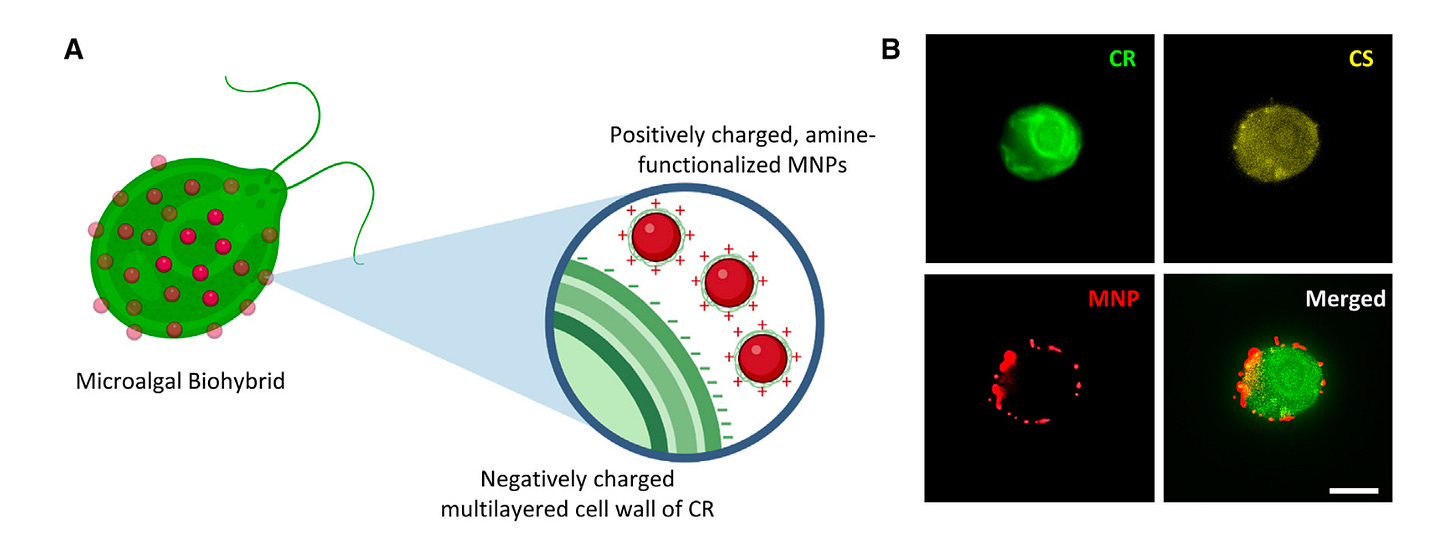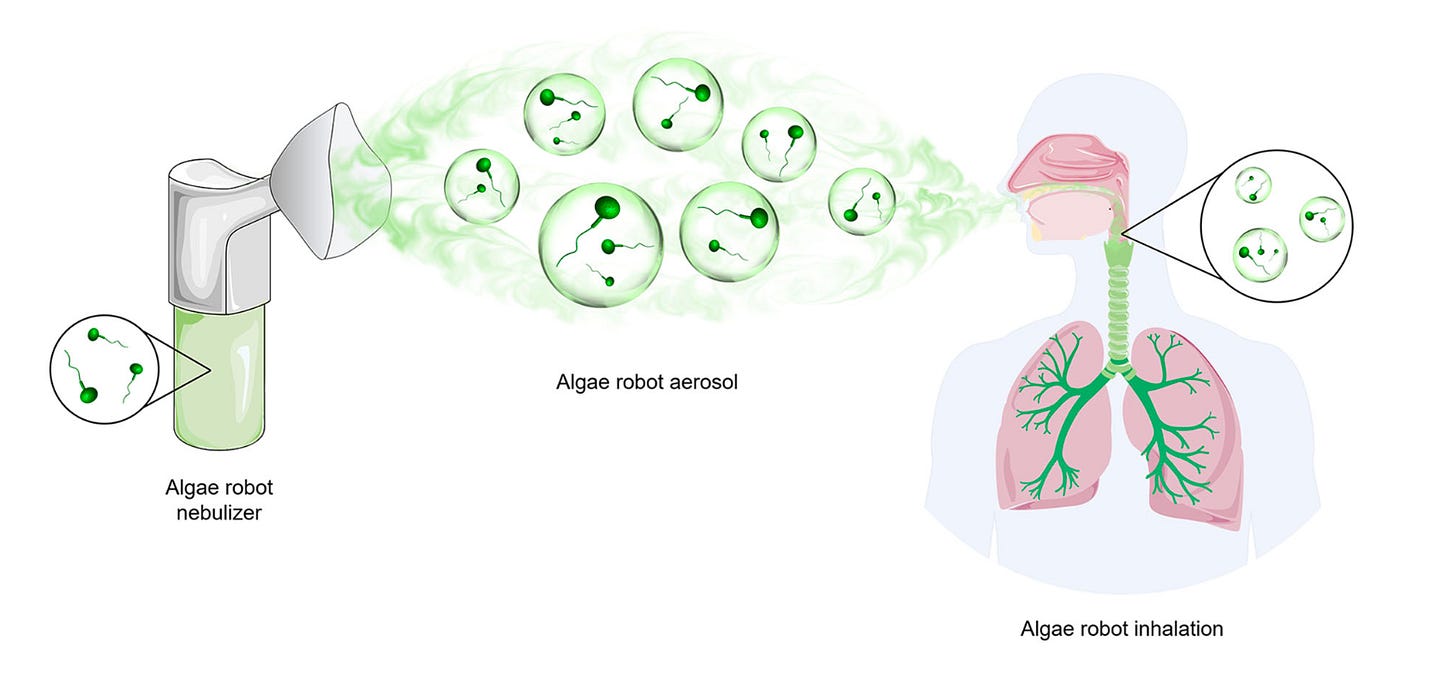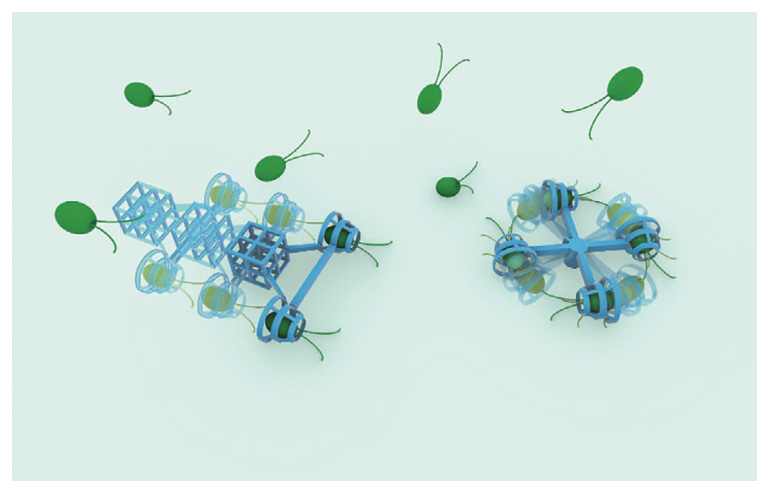Algae, Robot
Episode #06: Swimming algae microrobots (and the tumors who hate them)
In the previous episode of The Blob, we discussed algae apparel from head to toe. In this episode, we’re going from the outside in — from wearable to inhalable. That’s right, we’re talking about hybrid algal microrobots 🦾🤖🦠 .
Imagine a team of tiny green algae dressed in medicinal nanoparticles gliding through your veins. They navigate tight spaces and dense fluids, swimming directly to an infection site or a tumor. Upon arrival, they deliver a targeted and sustained payload. And when they’re through, they get naturally recycled into the body. It’s circular chemotherapy.
Now stop imagining, because the future of medicine is here. It’s alive (mostly), it’s green (literally), and it’s swimming (with a purpose).
Let’s get right into it, starting with the latest breakthrough 🔬
🏊🏼 Fluid Motion
Algae like Chlamydomonas reinhardtii have been training as swimmers for hundreds of millions if not billions of years. With their whip-like flagella (tiny tails), they’re basically cheetahs1 within the microbial environment.
Recently, researchers from the Max Planck Institute for Intelligent Systems have coated these green super-swimmers with magnetic nanoparticles (MNPs) which enabled them to guide the algae as they swam through viscous (read: mucus) environments and complex confined spaces like small microtubes.
In short, they’ve created a controllable molecular robot that can swim through your body.

This is not the only biohybrid microalgae robot (keep reading if you like cyborgs!), but the level of control is new, and it has enormous implications for drug delivery for cancer treatment specifically. The unrealized dream of cancer treatment is that chemotherapy drugs could be delivered exactly where they’re needed, in the right dose, at the right time, without collateral damage. The reality, however, looks more like a cellular Shock and Awe campaign.
The radiation that accompanies chemotherapy is a blunt tool, indiscriminately damaging healthy and damaged tissue alike. Based on secondary and tertiary sources (gratefully), it’s torturous. People get terribly sick, lose their hair, become immunocompromised, and often for naught.
Cancer drug development suffers from a 95% failure rate over 30 years, with only 30% of approved cancer drugs extending patient survival beyond 2.5 months.2 And in a world where humans increasingly ingest microplastics, we’re going to need to figure cancer out quickly —
Algae to the rescue!

In terms of implications (yet unrealized in human trials), here’s what we’re talking about:
🚚 Targeted Delivery: More drug to the right place.
Algae microrobots swim straight to the tumor, guided by magnets, light, or natural cues (like low oxygen or acidity)
🎯 Bonus: As algae photosynthesize (generating oxygen), they can help to treat tumors that are too low-oxygen for standard treatments to work.
🚣🏻 Active Movement: Fewer obstacles, deeper penetration.
Unlike passive particles, algae propel themselves, pushing through mucus and tissue to reach hidden tumor pockets.
📦 Localized Slow Release: High local dose, low body-wide exposure.
The chemotherapy is attached to the algae, often in slow-release nanoparticles, so it doesn’t spill out everywhere.
🛡 Immune Evasion: Longer circulation, better effect.
With smart coatings (like red blood cell membranes), algae can hide from the immune system long enough to do their job.
But before we go running carefree into the sunset, it may be helpful to understand how this would actually work in practice and what other solutions are being developed in the algal robotics world. Equally, if not more important, will anyone help me fund a theme park called “Algal Robotics World”? (DMs are open).
First things first — the journey of the little cancer torpedos:
Vaping to cure lung cancer?
The way algal cells would find their way into the body depends on the target and the species of algae, but the general idea is that it would be non or minimally invasive.
With an affliction the lungs you would either inhale them as a mist using a nebulizer, or as an aerosol with something like an asthma inhaler. Alternateively, they might be administered by an endotracheal tube down your throat, which is frankly less fun.
If inhalation is the method, then micromonas pusilla is the way to go. It’s one of the “picoplankton,” so easier to fit in an aerosol droplet. They’re about 1/10th the size of the chlamydomonas reinhardtii (1-2 micrometers vs. 10 - 12 micrometers), which would need to be administered by tube or injection.
The picoplankton can also stick around longer, evading macrophage white blood cells in the immune system and moving more nimbly through dense lung fluid. And that’s exactly what it did in trials on mice, where it was used to successfully treat pneumonia (Li, Z., Guo, Z., Zhang, F. et al.). However, a smaller surface area means less drug payload per cell.
For all other areas, though, from issues in the gastrointestinal tract or for targeted applications to tumors, the idea is that would swallow the algae in a capsule or drink. Perhaps that spirulina smoothie would seem less woo-woo if it was also filled with tiny algae cells containing Doxorubicin (a powerful chemotherapy drug)?
🕹️ MRI video games?
Once inside the body, doctors can use magnetic fields from the outside to steer the algae. In lab experiments, researchers use specially shaped magnetic coils to “pull” or “steer” the algae through narrow channels that mimic blood vessels or tissues. The algae can also be labeled with fluorescent markers so they’re easier to see and track with specialized imaging equipment (like an MRI or PET scan).
This tech is still in the early stages for humans, but it works well in animal models and on microfluidic (or “lab-on-a-chip”) devices.
Perhaps they could be guided handheld device (I’m visualizing something like an ultrasound imaging handheld), or maybe after ingestion, you could be placed for a time in an MRI machine, where doctors can basically play Space Invaders at a molecular scale 🤔
Thinking out loud, is it ever too late to go to med school? 👾
Distributing the Future
As William Gibson famously said, “The future is already here – it’s just not very evenly distributed.” So, how close are we to a distributed future of medicinal biohybrids? Are we ready to jump from lab to neighborhood pharmacy? Not yet, no. But hopefully soon.
One key hurdle is that clinical trials in mice have gone quite well. Researchers have successfully navigated lungs, fought cancer, and delivered antibiotics to cure pneumonia with no adverse side effects.
And we know that mice are often the harbingers of big things to come…
However, researchers are still figuring out how to safely guide and track the algae through complex, living human tissue — especially when it comes to reaching deep organs and controlling movement in real-time (with no surgery, IVs, and fewer side effects.)
Thankfully, scientists don’t just have one horse in the race. Actually, it could be said they have a team of horses. So far, we’ve been discussing what are known (by very few people, to be fair) as Microalgae-Flagellated Robots (or MFRs). These are the robots propelled by a living, unaltered algal cell.
Let’s meet the other team members:
🐎 Your Chariot Flagellates!🐎
Flagellates, Hybrids, and Templates
🏊♂️ Microalgae-Flagellated Robots (MFRs)
“Just put me in the pool, coach”
These are the pure swimmers — living microalgae whose natural flagella provide the sole means of propulsion through liquid environments. Scientists don’t alter the algae itself, but they do saddle it with magnetic nanoparticles (as shown above), drugs, or a very small harness/microtrap.
The idea of the microtrap is to harness the propulsive force of the algae, making it like a little beast of burden within the liquid environment, tilling and carrying heavy loads.
They’re drawn to light (phototaxis) and certain chemical environments (chemotaxis), but they can also be controlled by magnets.
🦠🦿 Microalgae-Hybrid Robots (MHRs)
“I’m just your friendly neighborhood cyborg”
MHRs are true biohybrids — part microalgae, part synthetic machine. The microalgae are combined with synthetic elements in a more integrated, functional way — think: algae encased in a tiny propeller fused with polymer frameworks or bonded with smart materials that respond to heat or pH.
The algae may still propel and produce oxygen, but they’re enhanced, allowing for greater control and programmability.
One of the downsides of not using the natural algae cell is complexity — both in terms of fabrication and also in terms of reducing algae’s natural strengths. For example, algae's natural swimming abilities may be hindered by overloading.
One example of an MHR would be the algae-NP(DOX) robot, which was used to target cancerous lung cells in mice. It was coated with red blood cell membrane and magnetic nanoparticles and loaded with doxorubicin (a chemotherapy drug).
🤖 Microalgae-Templated Robots (MTRs)
“I am reborn, but not living”
In this case, algae served as templates or molds to create synthetic robots that mimic their functions. For example, a silica shell might be grown around an algal cell; then, the biological part is removed, leaving a hollow shell with just the right proportions for maneuvering. It’s algae-inspired bio-engineering.
MTRs are very stable and durable, so they can perform functions like long-term, durational drug release or even environmental monitoring — especially in harsh conditions that might kill living algae. They can be powered by external forces like magnetic fields or propulsion from chemical reactions
🤷🏻♀️ So What? Who Cares? 🤷🏼
Algae are already generally regarded as safe (they have GRAS status from the FDA), so there shouldn’t be any real issues with regulatory acceptance. No real hurdles with production, either. Algae are easy enough to cultivate, especially at the scale needed for these niche applications.
The potential here is huge:
Cancer therapy: ~$200B global market by 2030.
Pulmonary drug delivery: >$50B by 2030.
Targeted drug delivery: CAGR of ~15%, expected to surpass $80B globally by 2030.
If I were a biotech PhD or a pharma company, I’d want to land a patent-protected drug delivery platform or maybe license a wastewater treatment/decontamination algae bot. If I manufactured inhalers or nebulizers, I’d be watching these innovations closely to get ahead of the patient interface. If I managed a hospital or healthcare system, I would be very excited about the possibility of increasing chemo efficacy, bringing down treatment costs associated with blunt cancer treatments, and generally looking to adopt those algal efficiencies. And if I were an investor or VC in the health tech space, I’d want to be watching all of the above.
There’s still work in the lab to do. Additional research and human trials, mainly, but regulatory approvals will be within a handful of years (optimistically but reasonably), so maybe some diligence is due!
📚 The Papers 🗞️
To be honest, I did a bit of skimming here 😅 Also, thank (insert higher power) for scientific graphics and renderings
H. Oda, N. Shimizu, Y. Morimoto, S. Takeuchi, Harnessing the Propulsive Force of Microalgae with Microtrap to Drive Micromachines. Small 2024, 20, 2402923.
Li, Z., Guo, Z., Zhang, F. et al. Inhalable biohybrid microrobots: a non-invasive approach for lung treatment. Nat Commun 16, 666 (2025).
Y. Alapan, O. Yasa, B. Yigit, et al. Microrobotics and Microorganisms: Biohybrid Autonomous Cellular Robots. Annual Review of Control, Robotics, and Autonomous Systems, Vol. 2:205-230 (2019)
Navigating Microalgal Biohybrids Through Confinements with Magnetic Guidance, Akolpoglu, Mukrime Birgul et al. Matter, Volume 0, Issue 0, 102052
Ziqiao Li, Ting Liu, Xiang Sun, Qi Zhou, Xiaohui Yan, Natural algae-inspired microrobots for emerging biomedical applications and beyond, Cell Reports Physical Science, Volume 5, Issue 6, 2024, 101979, ISSN 2666-3864
Hui Huang, Yutong Lang, Shoujie Wang, Min Zhou, Microalgae-based drug delivery systems in biomedical applications, Engineered Regeneration, Volume 5, Issue 3, 2024, Pages 361-374, ISSN 2666-1381,
Schmidt, C.K., Medina-Sánchez, M., Edmondson, R.J. et al. Engineering microrobots for targeted cancer therapies from a medical perspective. Nat Commun 11, 5618 (2020).
Zhang F, Guo Z, Li Z, Luan H, Yu Y, Zhu AT, Ding S, Gao W, Fang RH, Zhang L, Wang J. Biohybrid microrobots locally and actively deliver drug-loaded nanoparticles to inhibit the progression of lung metastasis. Sci Adv. 2024 Jun 14;10(24):eadn6157. doi: 10.1126/sciadv.adn6157. Epub 2024 Jun 12. PMID: 38865468; PMCID: PMC11168470.
Cartoon
Algae are super small, so they’re obviously not going to cover much distance. They move at 0.2 mm/s. That’s micrometers and slower than a snail, which covers a blazing 1-3 mm/s. 🐌But in terms of how fast they move compared to body length, that’s a different story!
Algae move above 10-20 times their body length a second. To put into context, Cheetahs (at their top speed) briefly move at about 18-19 body lengths per second (about 65 mph). 🐆
If algae were a human, it would basically be running one-second hundred-meter dashes 🏃🏻♂️
Usain Bolt, eat your heart out!
Sun D, Macedonia C, Chen Z, Chandrasekaran S, Najarian K, Zhou S, Cernak T, Ellingrod VL, Jagadish HV, Marini B, Pai M, Violi A, Rech JC, Wang S, Li Y, Athey B, Omenn GS. Can Machine Learning Overcome the 95% Failure Rate and Reality that Only 30% of Approved Cancer Drugs Meaningfully Extend Patient Survival? J Med Chem. 2024 Sep 26;67(18):16035-16055. Epub 2024 Sep 10. PMID: 39253942.









I’m glad I found you. I’ve always loved seaweed.